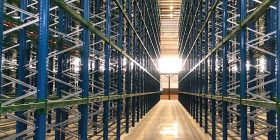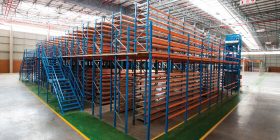So, you’re ready to transition to vertical storage. We’re not surprised! Our customers have optimised their operations, reduced space-related expenses, and better utilised high-demand industrial properties by doing just that. While there are various warehouse storage solutions available, two popular options—Very Narrow Aisle (VNA) racking and selective storage racking—are chosen for their unique advantages. We’re excited to unpack their key differences, benefits and disadvantages in operations and help you decide the correct solution for your needs.
Quick Definitions: Selective Storage Racking vs. VNA Racking
Very Narrow Isle Racking
As the name implies, these are a compact version of typical adjustable pallet racking systems, that produce a high-density storage system allowing you to expand your warehouse capacity without requiring more space.
Racking with Selective Storage
Also called Selective Non-Palletised Storage Racks, this type of storage system has a more straightforward construction. It can have any kind of decking that the end user wants, including steel, open and closed slatted pine timber decking, and more. Because of their adaptability, selected racking solutions are ideal for use with other storage systems, most commonly pick-face racking systems.
Strengths and Weaknesses in Industrial Applications
SA’s industrial property market is experiencing rental rate increases, reflecting strong demand for these spaces. This demand makes efficient space utilization vital for logistics and distribution companies aiming to maintain cost-effectiveness. Vacancy rates are notably low, averaging 3.6% compared to the long-term average of 4.7%, indicating high demand and limited availability. As rental costs continue to climb, businesses are under pressure to optimise their existing warehouses, often by making the most of vertical storage. You can confidently expand your systems when you have a clear picture of the advantages and disadvantages of each product.
Advantages of VNA Racks
- High Space Efficiency: Designed for warehouses with limited space, it optimises floor and vertical space by requiring narrower aisles.
- Increased Storage Density: Can accommodate more pallets within the same warehouse footprint compared to selective racking.
- Ideal for High Turnover: Suitable for operations with high inventory rotation, especially when paired with specialised VNA forklifts for faster access.
- Customisation: Can be tailored to accommodate various pallet sizes and storage requirements.
- Supports High Ceilings: Leverages all your vertical space, making it ideal for warehouses that are above 3 stories (9.8 metres).
Advantages of Selective Non-Palletised Storage Racks
- Versatility in Goods Storage: Suitable for storing a wide range of non-palletised items, such as cartons, boxes, or irregularly shaped goods, making it ideal for warehouses with diverse inventory types.
- Customisable Shelving Options: Can be configured with various shelf sizes and materials to accommodate goods of different weights and dimensions, offering flexibility in storage setups.
- Direct Access: Provides direct and unrestricted access to all stored items, enabling faster retrieval and restocking of non-palletised goods.
- Ease of Adjustment: Shelves can be easily adjusted or repositioned to accommodate changes in inventory size or type, ensuring adaptability to evolving warehouse needs.
- Cost-Effective: A budget-friendly solution for warehouses that do not require high-density pallet storage systems or specialised equipment.
- Simplified Installation: Quick and straightforward to install, making it a practical choice for warehouses needing an efficient setup.
- Optimised Organisation: Helps create a well-organised system for storing non-palletised items, reducing clutter and improving warehouse workflow.
Disadvantages of Very Narrow Isle Racking System
- Higher Initial Investment:
VNA racking systems require specialised equipment like narrow-aisle forklifts or turret trucks, significantly increasing upfront costs compared to the simplicity of non-palletised racks. - Less Suitable for Non-Palletised Items:
Designed primarily for palletised goods, it is less versatile for accommodating irregularly shaped or non-palletised items that selective non-palletised racks handle efficiently. - Complex Installation and Maintenance:
This system involves a more complex and costly installation process, including floor reinforcements or precision levelling, which is unnecessary for non-palletised racks. - Reduced Flexibility:
Once installed, VNA racking systems are less adaptable to changes in storage needs. Non-palletised racks, by contrast, can be easily adjusted to accommodate different item sizes and storage configurations. - Specialised Training Required:
VNA systems rely on specific equipment and trained operators, adding operational complexity and ongoing costs for training and maintenance, whereas non-palletised racks can be used with standard equipment and minimal training. - Not Ideal for Smaller Warehouses:
They are best suited for large-scale operations with high ceilings and significant storage needs. For smaller warehouses with diverse inventory, non-palletised racks are often a more practical and efficient choice. - Longer Lead Time for Setup:
The installation and setup of VNA racking systems often take longer, which can delay warehouse operations. Non-palletised racks are quicker to install and get operational.
Disadvantages of Selective Storage Racks
- Lower Space Utilisation:
Selective non-palletised racks require wider aisles and cannot match the space efficiency of VNA pallet racking, which is designed to get the most out of spaces with narrower isles. - Limited Storage Density:
While versatile, non-palletised racks typically offer lower storage density compared to VNA racking, which can store more goods within the same warehouse footprint due to its compact design. - Height Limitations:
Selective non-palletised racks make the most of high warehouse ceilings. - Less Optimised for High Turnover:
Non-palletised racks rely on manual handling for retrieval, which can slow down operations in warehouses with high inventory turnover. VNA systems paired with specialised forklifts ensure quicker access. - No Automation Compatibility:
Non-palletised racks generally lack compatibility with automation or advanced material handling equipment, whereas VNA pallet racking can integrate seamlessly with automated systems for increased efficiency. - Operational Limitations:
Non-palletised racks may not support the systematic organisation and retrieval processes that VNA racking enables, especially for large-scale operations requiring precise inventory management.
Conclusion
Your warehouse operations can be transformed by choosing the best storage solution, which can increase output and cut expenses. In this comparison between Selective Storage Racks vs VNA racking, we’ve seen that both provide special advantages catered to various logistic and distribution requirements. Knowing the pros and cons of both options is essential to choosing wisely, whether you value the flexibility and affordability of non-palletized racks or high-density storage with VNA systems.
As the top warehouse racking installer in South Africa, Krost Shelving and Racking specialises in creating custom storage solutions that meet your unique needs. We are here to help you maximise your warehousing thanks to our extensive knowledge and dedication to excellence.
Get in touch with us right now to talk about your storage requirements and to begin remodelling your warehouse using our superior solutions and unbeatable advice!











